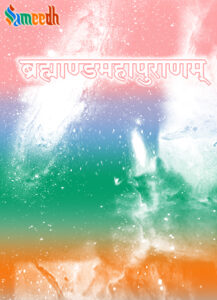The Brahmand Puran is one of the eighteen Mahāpurāṇs in Hinduism. It is a significant text that addresses various aspects of Hindu cosmology, mythology, genealogies, rituals, and legends. The name “Brahmand” translates to “The Cosmic Egg,” symbolizing the universe’s creation and expansion.

Like many other Purans, the Brahmand Puran includes genealogies of deities, sages, and legendary figures. It provides information about various dynasties and their historical contributions. The text details the structure of the cosmos, including the layout of various lokas (worlds or realms), the geography of the earth, and the celestial bodies. It explores the concept of time cycles and the repetitive nature of creation.
The Puran discusses the incarnations (avatars) of Lord Vishnu, including the well-known avatars like Matsya (the fish), Kurma (the turtle), Varaha (the boar), and others. Numerous mythological stories are found in the Brahmand Puran, covering various deities, demons, and celestial beings. These stories often convey moral and spiritual lessons.
The Brahmand Puran contains numerous stories covering various aspects of Hindu mythology, cosmology, and spirituality. Here are a few popular stories from the Brahmanda Purana:
- Creation of the Universe: The Brahmand Puran provides an elaborate account of the creation of the universe, often presented as a cosmic egg (Brahmand). This story explains the emergence of various elements, deities, and cosmic cycles.
- Churning of the Ocean (Samudra Manthan): A well-known story found in the Brahmand Puran is the churning of the ocean, a joint effort by the Devs (celestial beings) and Asurs (demons) to obtain the nectar of immortality (amrit). This narrative is also present in other Purans like the Bhagavad Puran and Mahabharat.
- Story of Ganesh’s Birth: The Brahmand Puran provides a version of the story of Ganesh’s birth. In this narrative, Parvati creates Ganesh out of her own body, and he later becomes the scribe for Vyas as he composes the Mahabharat.
- Kurma Avatar (The Tortoise Incarnation): The Brahmand Puran describes the Kurm Avatar of Lord Vishnu, where he takes the form of a turtle to support Mount Mandara during the churning of the ocean.
- Markandeya’s Story: The Puran includes the story of Markandeya, a devout young sage who is blessed with the vision of Lord Vishnu while facing death. Vishnu appears in the form of a young child, calming the sage and granting him eternal life.
- Sati and Shiva: The Brahmand Puran narrates the story of Sati, the first wife of Lord Shiv, and her self-immolation due to her father Daksha’s disrespect towards Shiv. This event leads to the manifestation of the fierce goddess Kali and later the birth of Parvati.
- Story of Matsya Avatar: The Purana recounts the story of Matsya Avatar, where Lord Vishnu takes the form of a fish to save the sage Manu and the Saptarishi (seven sages) during a great flood.
- Karttikey’s Birth: The Brahmand Purana provides details about the birth of Karttikey (also known as Skanda or Murugan), the son of Lord Shiv and Parvati. This narrative is significant in Hindu mythology.
These stories, among others, contribute to the rich tapestry of Hindu mythology and provide insights into cosmology, ethics, and the divine. Keep in mind that variations of these stories might be found in other Puranas and Hindu scriptures.
The Brahmand Puran, like other Mahapuraṇs, plays a crucial role in preserving and transmitting cultural, religious, and philosophical knowledge within Hinduism. It provides a comprehensive understanding of the cosmos and serves as a guide for individuals seeking spiritual wisdom.